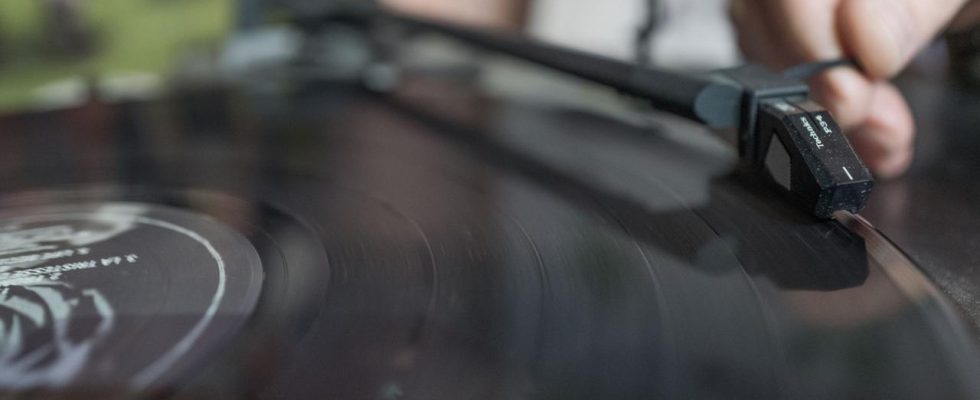The vinyl record is 75 years old today. But on the anniversary of all things a hangover threatens. Many in the industry are certain: the growth of recent years is over.
Edward Wallerstein, head of Columbia Records, has announced a “world sensation” for June 21, 1948 at the Hotel Waldorf-Astoria in New York. He puts on a record in front of the assembled journalists. Vinyl records have been around for decades. But this one is different. The sound knocks everyone off their feet: Felix Mendelssohn Bartholdy’s Violin Concerto in E minor, Opus 64, sounds clearer than ever. Columbia calls the record made of the still relatively young plastic polyvinyl chloride “Long-playing microgroove record” – in short: LP. A short time later, it is the industry standard.
Since then, the vinyl record has been through a lot. Ups and downs. It was declared dead when CDs overtook LPs in the 1990s. Things have been looking up lately: LPs have experienced a real boom in recent years – because music lovers have rediscovered them as a counterpoint to digital music streaming. But that could be the end of it now.
Stamping plants suffer from high costs
“The hype is over,” says Patrick Kroehn. He runs a pressing plant in Freiberg am Neckar – mainly for smaller productions, sometimes 300, sometimes 500 copies per artist. Demand has dropped significantly in recent months. There are several reasons for this: On the one hand, the costs have exploded due to the corona pandemic and the energy crisis. “The production of a record costs almost twice as much as before Corona,” says Kroehn. Many of his customers could no longer afford production costs of 16 instead of eight euros per piece.
Björn Bieber from Pforzheim is also observing a certain unrest in the industry. He has long operated a “one-man stamping shop” in his garage, but shut it down in 2021. One of the reasons: at some point in the industry it was all about money. “Many didn’t even understand what the medium of vinyl is all about,” he says. For him, vinyl means lifeblood, passion, subculture. But suddenly people went into business to make money with the hype. “These will be the first to go bankrupt,” says Bieber.
“The market is saturated”
Because the order situation is no longer so good. In many places, the presses are even standing still, after many new pressing plants had opened in recent years. The long waiting times in production are also over. Until recently, even big stars like Adele or James Blake had to postpone the release of their new albums because of the jams in the pressing plants.
In the meantime, however, every successful record of the past decades has been reissued umpteen times, the big record companies have exploited what was possible. “The market is saturated,” says Bieber. So far, however, it has been more of a crisis for the manufacturers. Music consumers will continue to buy long-playing records.
Sales fell again in 2022
The question is: How much longer will the customers keep up? Because the manufacturers naturally pass on the increased production costs. Rainer Rupp runs one of the most renowned record shops in Germany in Stuttgart, with a large range of used and new records. Especially with new goods, he observes that customers are becoming more cautious. “A simple record now costs more than 40 euros,” says Rupp. “This won’t last long.”
The current sales figures for vinyl could also be an indication of this: According to the Federal Association of the Music Industry, sales in 2022 fell again for the first time in four years – by 200,000 units to 4.3 million vinyl records sold. That’s still significantly more than at the low point in 2006, when there were just 300,000 units. With 1.6 billion digital music streams and downloads, however, it is also clear that vinyl has never left its niche when viewed only in terms of sales.
Climate balance could become more and more important
And something else could hit the industry more in the coming years. Due to the increased environmental awareness of people, the LP has also increasingly become the focus of environmentalists. Because PVC, the raw material for the record, consists mainly of petroleum. In addition, the production is energy-intensive and CO2-intensive.
The disposal of records can also be problematic. “PVC is generally recyclable,” says Michael Jedelhauser from the NABU nature conservation association. Nevertheless, discarded records have mostly ended up in incinerators for cost reasons. After all, there are more and more manufacturers on the market who advertise with records made of recycled PVC. But production is still in its infancy and could be nipped in the bud by the looming crisis.
“History repeats itself,” says Björn Bieber in Pforzheim, who is reminded of the first burglary in the 1990s. But the crisis could also do good things: the subculture could perhaps get the vinyl record back when the hype is over. His colleague Patrick Kroehn in Freiberg takes a similar view: “Vinyl will never die. But it will become more of a niche again.” But the LP has experienced that many times in its 75-year history.

